Abstract
Nicotinamide and carbogen breathing are both effective radiosensitisers in experimental tumour models and are even more effective in combination. This study was to investigate the feasibility of using the agents in combination in patients and to measure their effect on tumour oxygenation. Twelve patients with advanced malignant disease were treated with 4-6 g of oral nicotinamide (NCT) in tablet formulation. Ten of these 12 patients breathed carbogen (95% oxygen, 5% carbon dioxide) for up to 20 min at presumed peak plasma NCT concentration (Cpeak) and had tumour oxygen partial pressure (pO2) measured using the Eppendorf pO2) histograph. The mean Cpeak values were 82, 115 and 150 micrograms ml-1 for NCT doses of 4, 5 and 6 g respectively and were dose dependent. The time of Cpeak was independent of dose with an overall mean of 2.4 h (range 0.7-4 h). NCT toxicity occurred in 9 out of 12 patients and was mild in all but one; carbogen was well tolerated in all patients. Following NCT only two patients had significant rises (P < 0.05) in tumour median pO2. During carbogen breathing, eight out of ten patients had early highly significant rises in pO2 (P < 0.0001), of which six continued to rise or remained in plateau until completion of gas breathing. Six patients had hypoxic pretreatment values less than 5 mmHg, which were completely abolished in three and reduced in two during carbogen breathing. In conclusion, the combination of NCT and carbogen breathing was generally well tolerated and gave rise to substantial rises in tumour pO2 which were maintained throughout gas breathing. These results should encourage further study of this potentially useful combination of agents as radiosensitisers in the clinic.
Full text
PDF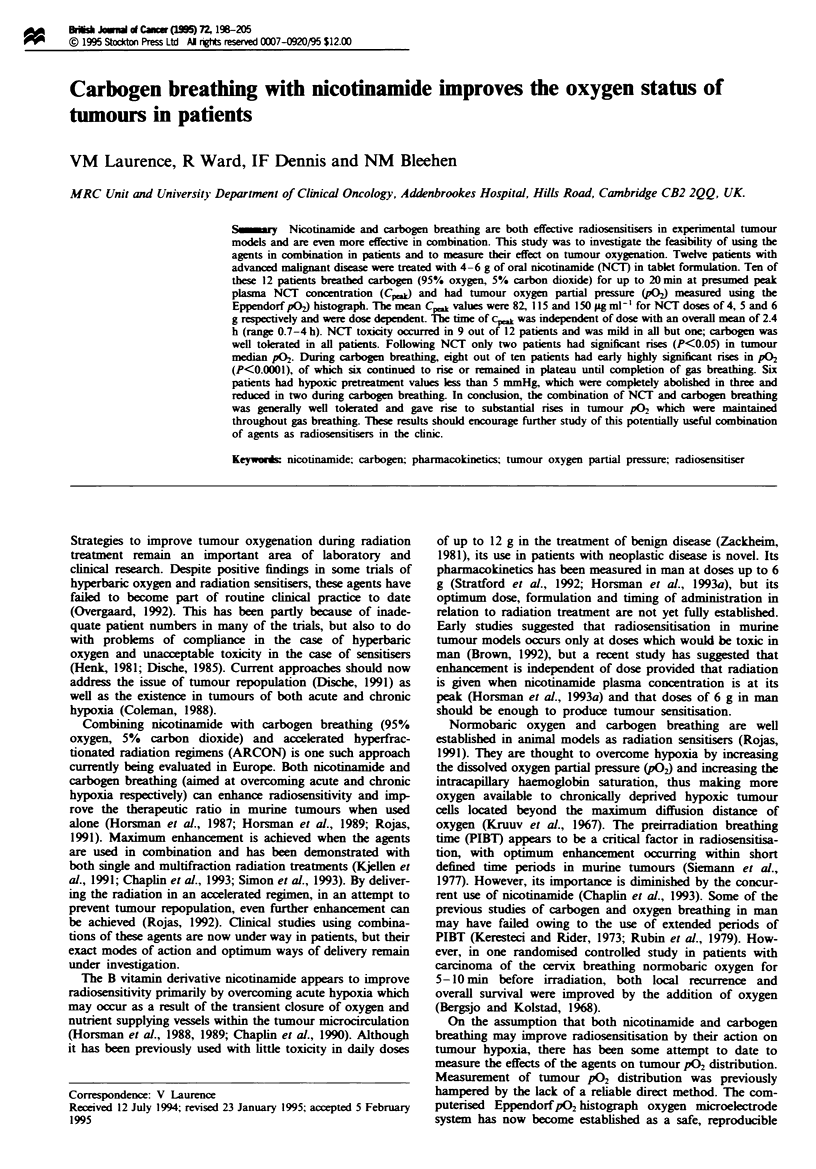
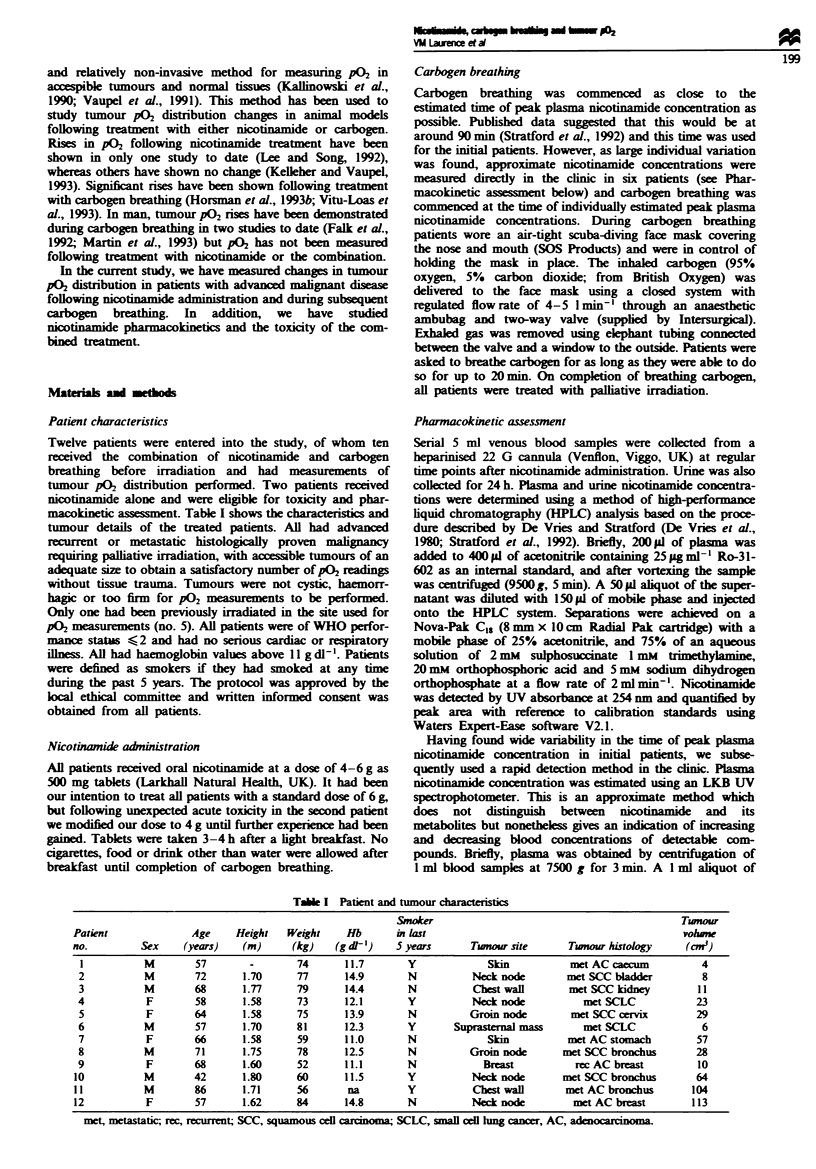
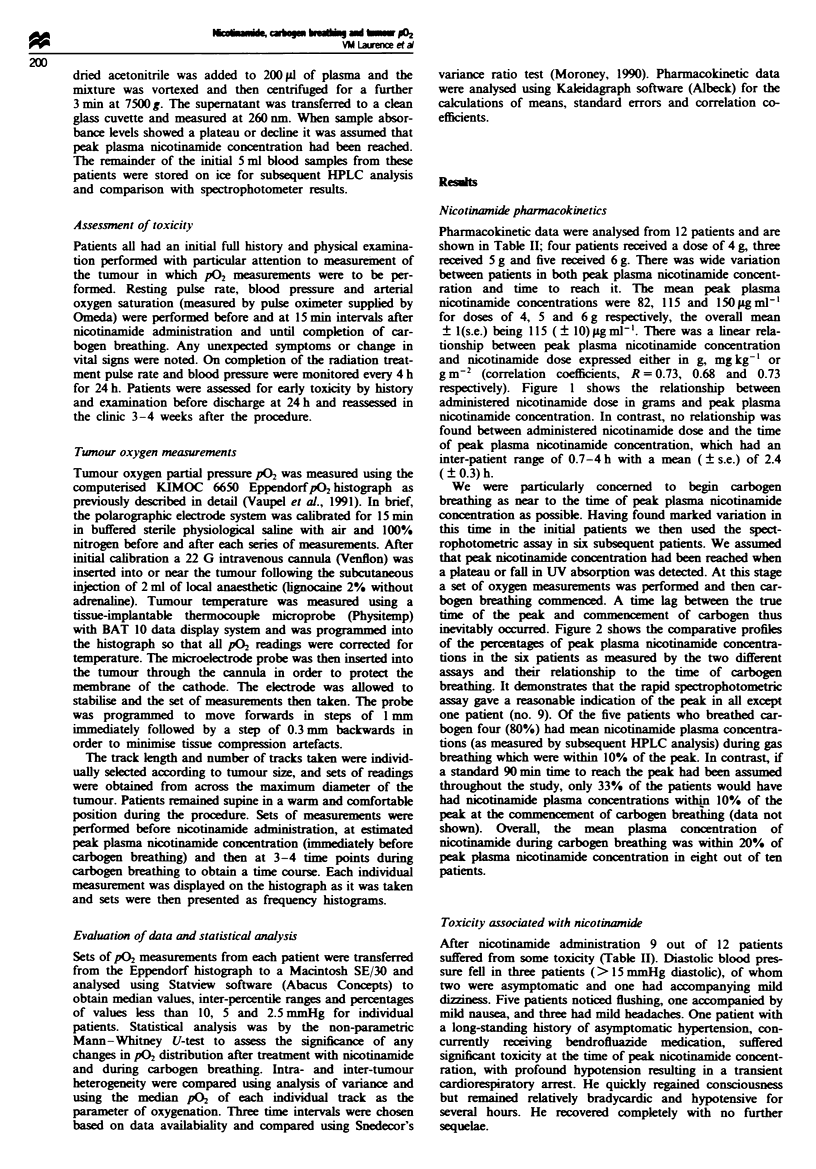
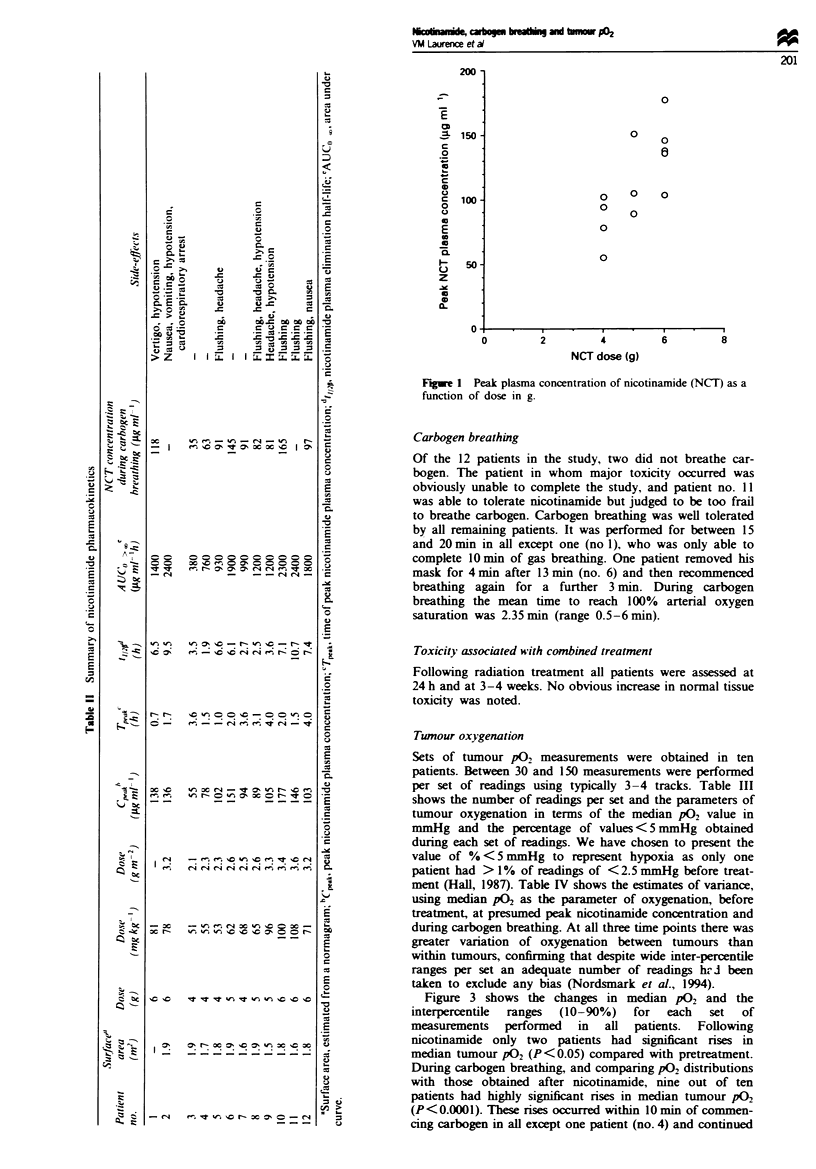
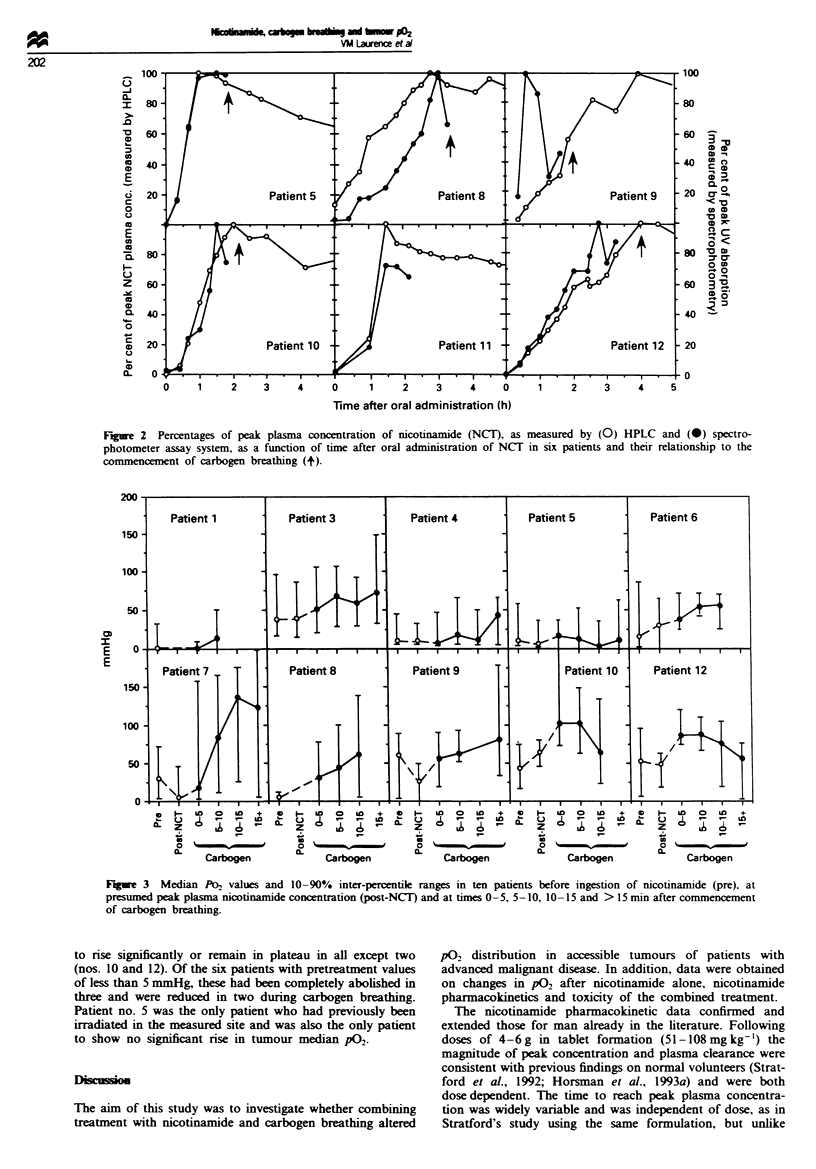
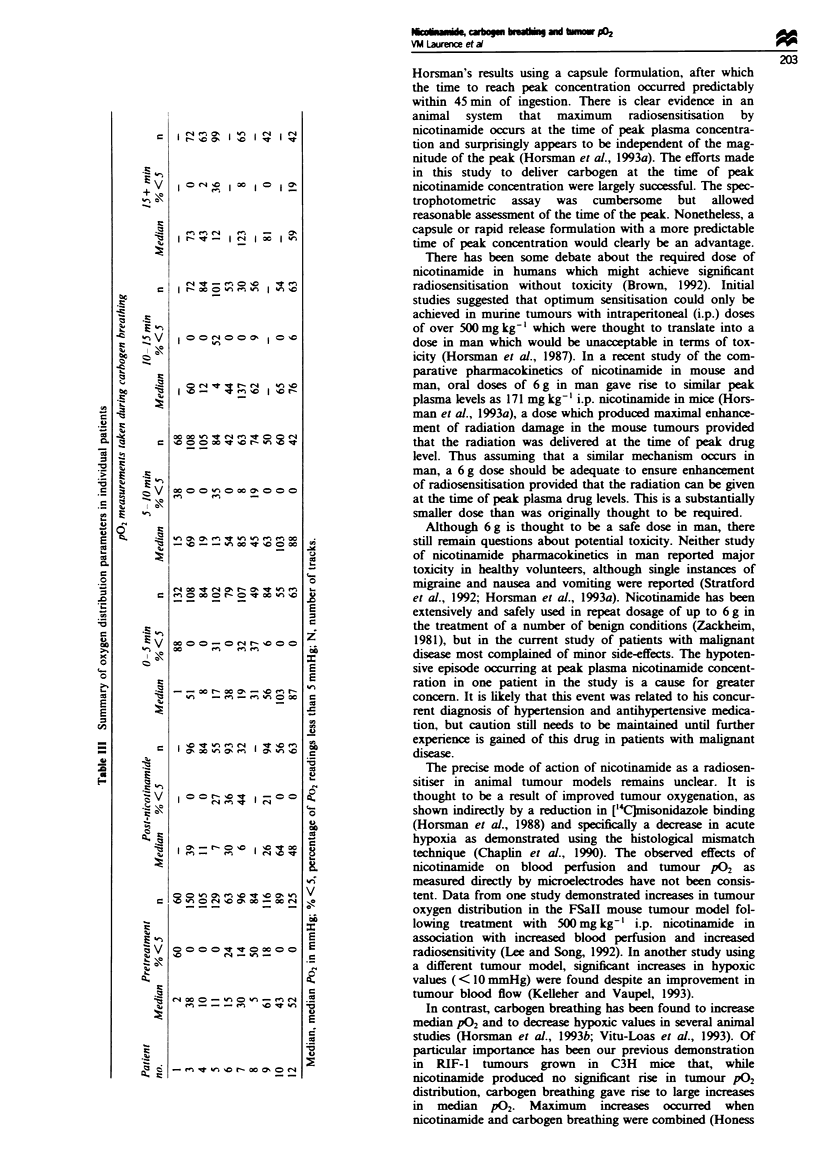
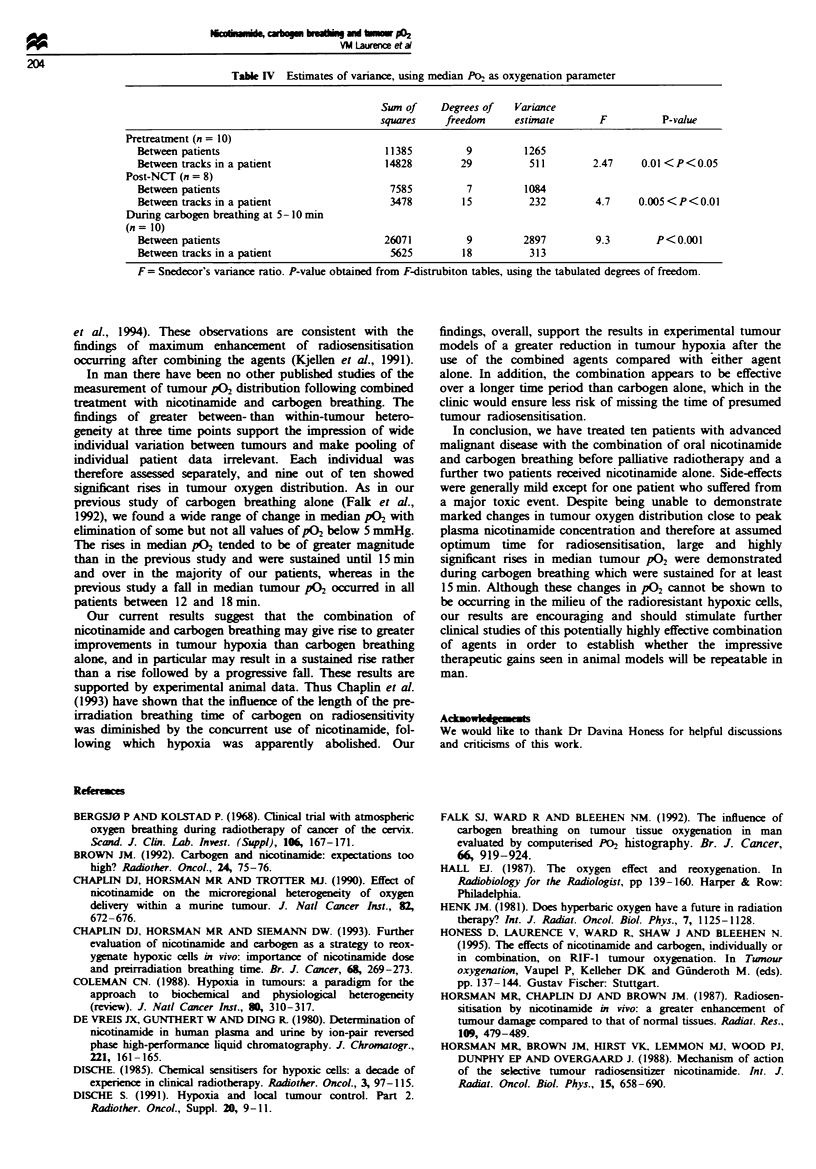
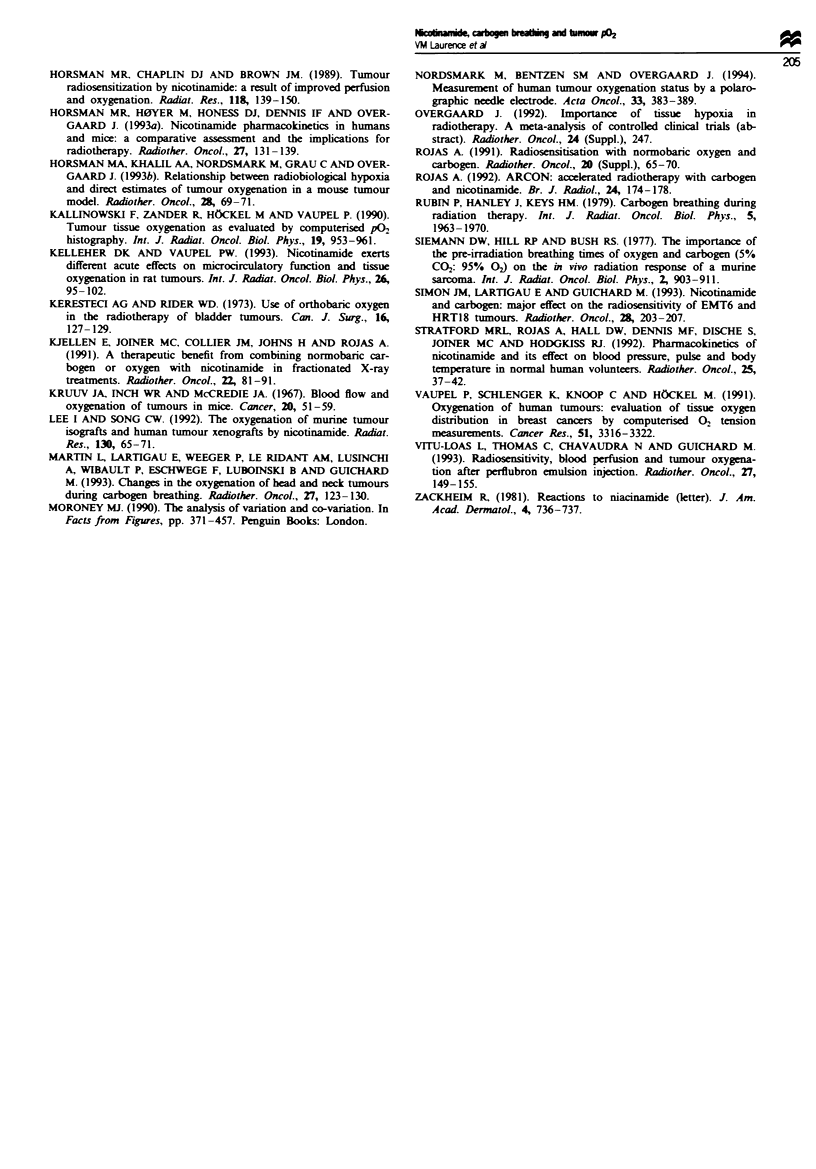
Selected References
These references are in PubMed. This may not be the complete list of references from this article.
- Bergsjo P., Kolstad P. Clinical trial with atmospheric oxygen breathing during radiotherapy of cancer of the cervix. Scand J Clin Lab Invest Suppl. 1968;106:167–171. [PubMed] [Google Scholar]
- Brown J. M. Carbogen and nicotinamide: expectations too high? Radiother Oncol. 1992 Jun;24(2):75–76. doi: 10.1016/0167-8140(92)90281-x. [DOI] [PubMed] [Google Scholar]
- Chaplin D. J., Horsman M. R., Siemann D. W. Further evaluation of nicotinamide and carbogen as a strategy to reoxygenate hypoxic cells in vivo: importance of nicotinamide dose and pre-irradiation breathing time. Br J Cancer. 1993 Aug;68(2):269–273. doi: 10.1038/bjc.1993.326. [DOI] [PMC free article] [PubMed] [Google Scholar]
- Chaplin D. J., Horsman M. R., Trotter M. J. Effect of nicotinamide on the microregional heterogeneity of oxygen delivery within a murine tumor. J Natl Cancer Inst. 1990 Apr 18;82(8):672–676. doi: 10.1093/jnci/82.8.672. [DOI] [PubMed] [Google Scholar]
- Coleman C. N. Hypoxia in tumors: a paradigm for the approach to biochemical and physiologic heterogeneity. J Natl Cancer Inst. 1988 May 4;80(5):310–317. doi: 10.1093/jnci/80.5.310. [DOI] [PubMed] [Google Scholar]
- Dische S. Chemical sensitizers for hypoxic cells: a decade of experience in clinical radiotherapy. Radiother Oncol. 1985 Feb;3(2):97–115. doi: 10.1016/s0167-8140(85)80015-3. [DOI] [PubMed] [Google Scholar]
- Dische S. Hypoxia and local tumour control. Part 2. Radiother Oncol. 1991;20 (Suppl 1):9–11. doi: 10.1016/0167-8140(91)90180-o. [DOI] [PubMed] [Google Scholar]
- Falk S. J., Ward R., Bleehen N. M. The influence of carbogen breathing on tumour tissue oxygenation in man evaluated by computerised p02 histography. Br J Cancer. 1992 Nov;66(5):919–924. doi: 10.1038/bjc.1992.386. [DOI] [PMC free article] [PubMed] [Google Scholar]
- Henk J. M. Does hyperbaric oxygen have a future in radiation therapy? Int J Radiat Oncol Biol Phys. 1981 Aug;7(8):1125–1128. doi: 10.1016/0360-3016(81)90173-5. [DOI] [PubMed] [Google Scholar]
- Horsman M. R., Brown J. M., Hirst V. K., Lemmon M. J., Wood P. J., Dunphy E. P., Overgaard J. Mechanism of action of the selective tumor radiosensitizer nicotinamide. Int J Radiat Oncol Biol Phys. 1988 Sep;15(3):685–690. doi: 10.1016/0360-3016(88)90312-4. [DOI] [PubMed] [Google Scholar]
- Horsman M. R., Chaplin D. J., Brown J. M. Radiosensitization by nicotinamide in vivo: a greater enhancement of tumor damage compared to that of normal tissues. Radiat Res. 1987 Mar;109(3):479–489. [PubMed] [Google Scholar]
- Horsman M. R., Chaplin D. J., Brown J. M. Tumor radiosensitization by nicotinamide: a result of improved perfusion and oxygenation. Radiat Res. 1989 Apr;118(1):139–150. [PubMed] [Google Scholar]
- Horsman M. R., Høyer M., Honess D. J., Dennis I. F., Overgaard J. Nicotinamide pharmacokinetics in humans and mice: a comparative assessment and the implications for radiotherapy. Radiother Oncol. 1993 May;27(2):131–139. doi: 10.1016/0167-8140(93)90133-s. [DOI] [PubMed] [Google Scholar]
- Horsman M. R., Khalil A. A., Nordsmark M., Grau C., Overgaard J. Relationship between radiobiological hypoxia and direct estimates of tumour oxygenation in a mouse tumour model. Radiother Oncol. 1993 Jul;28(1):69–71. doi: 10.1016/0167-8140(93)90188-e. [DOI] [PubMed] [Google Scholar]
- Kallinowski F., Zander R., Hoeckel M., Vaupel P. Tumor tissue oxygenation as evaluated by computerized-pO2-histography. Int J Radiat Oncol Biol Phys. 1990 Oct;19(4):953–961. doi: 10.1016/0360-3016(90)90018-f. [DOI] [PubMed] [Google Scholar]
- Kelleher D. K., Vaupel P. W. Nicotinamide exerts different acute effects on microcirculatory function and tissue oxygenation in rat tumors. Int J Radiat Oncol Biol Phys. 1993 Apr 30;26(1):95–102. doi: 10.1016/0360-3016(93)90178-x. [DOI] [PubMed] [Google Scholar]
- Keresteci A. G., Rider W. D. Use of orthobaric oxygen in the radiotherapy of bladder tumours. Can J Surg. 1973 Mar;16(2):127–129. [PubMed] [Google Scholar]
- Kjellen E., Joiner M. C., Collier J. M., Johns H., Rojas A. A therapeutic benefit from combining normobaric carbogen or oxygen with nicotinamide in fractionated X-ray treatments. Radiother Oncol. 1991 Oct;22(2):81–91. doi: 10.1016/0167-8140(91)90002-x. [DOI] [PubMed] [Google Scholar]
- Kruuv J. A., Inch W. R., McCredie J. A. Blood flow and oxygenation of tumors in mice. I. Effects of breathing gases containing carbon dioxide at atmospheric pressure. Cancer. 1967 Jan;20(1):51–59. doi: 10.1002/1097-0142(1967)20:1<51::aid-cncr2820200108>3.0.co;2-d. [DOI] [PubMed] [Google Scholar]
- Lee I., Song C. W. The oxygenation of murine tumor isografts and human tumor xenografts by nicotinamide. Radiat Res. 1992 Apr;130(1):65–71. [PubMed] [Google Scholar]
- Martin L., Lartigau E., Weeger P., Lambin P., Le Ridant A. M., Lusinchi A., Wibault P., Eschwege F., Luboinski B., Guichard M. Changes in the oxygenation of head and neck tumors during carbogen breathing. Radiother Oncol. 1993 May;27(2):123–130. doi: 10.1016/0167-8140(93)90132-r. [DOI] [PubMed] [Google Scholar]
- Nordsmark M., Bentzen S. M., Overgaard J. Measurement of human tumour oxygenation status by a polarographic needle electrode. An analysis of inter- and intratumour heterogeneity. Acta Oncol. 1994;33(4):383–389. doi: 10.3109/02841869409098433. [DOI] [PubMed] [Google Scholar]
- Rojas A. ARCON: accelerated radiotherapy with carbogen and nicotinamide. BJR Suppl. 1992;24:174–178. [PubMed] [Google Scholar]
- Rojas A. Radiosensitization with normobaric oxygen and carbogen. Radiother Oncol. 1991;20 (Suppl 1):65–70. doi: 10.1016/0167-8140(91)90190-r. [DOI] [PubMed] [Google Scholar]
- Rubin P., Hanley J., Keys H. M., Marcial V., Brady L. Carbogen breathing during radiation therapy-the Radiation Therapy Oncology Group Study. Int J Radiat Oncol Biol Phys. 1979 Nov-Dec;5(11-12):1963–1970. doi: 10.1016/0360-3016(79)90946-5. [DOI] [PubMed] [Google Scholar]
- Siemann D. W., Hill R. P., Bush R. S. The importance of the pre-irradiation breathing times of oxygen and carbogen (5% CO2: 95% O2) on the in vivo radiation response of a murine sarcoma. Int J Radiat Oncol Biol Phys. 1977 Sep-Oct;2(9-10):903–911. doi: 10.1016/0360-3016(77)90188-2. [DOI] [PubMed] [Google Scholar]
- Simon J. M., Lartigau E., Guichard M. Nicotinamide and carbogen: major effect on the radiosensitivity of EMT6 and HRT18 tumours. Radiother Oncol. 1993 Sep;28(3):203–207. doi: 10.1016/0167-8140(93)90059-h. [DOI] [PubMed] [Google Scholar]
- Stratford M. R., Rojas A., Hall D. W., Dennis M. F., Dische S., Joiner M. C., Hodgkiss R. J. Pharmacokinetics of nicotinamide and its effect on blood pressure, pulse and body temperature in normal human volunteers. Radiother Oncol. 1992 Sep;25(1):37–42. doi: 10.1016/0167-8140(92)90193-x. [DOI] [PubMed] [Google Scholar]
- Vaupel P., Schlenger K., Knoop C., Höckel M. Oxygenation of human tumors: evaluation of tissue oxygen distribution in breast cancers by computerized O2 tension measurements. Cancer Res. 1991 Jun 15;51(12):3316–3322. [PubMed] [Google Scholar]
- Vitu-Loas L., Thomas C., Chavaudra N., Guichard M. Radiosensitivity, blood perfusion and tumour oxygenation after perflubron emulsion injection. Radiother Oncol. 1993 May;27(2):149–155. doi: 10.1016/0167-8140(93)90135-u. [DOI] [PubMed] [Google Scholar]
- de Vries J. X., Günthert W., Ding R. Determination of nicotinamide in human plasma and urine by ion-pair reversed-phase high-performance liquid chromatography. J Chromatogr. 1980 Nov 14;221(1):161–165. doi: 10.1016/s0378-4347(00)81019-1. [DOI] [PubMed] [Google Scholar]


